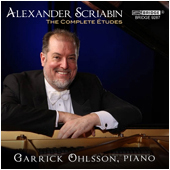
ESSENTIAL RECORDINGS

Alexander Scriabin composed his first attempt at a piano study, the Etude Op. 2, No. 1 in 1887,
when he was only 15 years old, but there is absolutely nothing juvenile about it. The mastery of the keyboard, the unusual but yet
precise harmonies, the elongated melodic lines, the use of dynamics as an integral part of the music's development, the sometimes
subtle and sometimes bold technical demands ... all of these qualities and more are in strong evidence in this early work. By
definition, Etudes are musical essays on technical issues and how to resolve them. For example, although this first Etude may
sound simple and easy to perform, that is far from being the case. The whole piece is a continuous series of large chords,
some built on as many as 8 notes, with the top note of each one forming the melody, and a very beautiful melody at that. Well,
if you are not a pianist, you can't imagine how difficult it can be, and how much concentrated effort it takes, to make that
top note stand out from the crowd. Garrick Ohlsson, the ever versatile and master interpretive pianist,
who has been winning awards and collecting prizes since as far back as 1966, achieves that task perfectly and even accents
the left hand's counter-melody just as well. In fact, all 26 Etudes are given the same approach ... musical content first,
technical wizardry second, which is what makes this recording of the Scriabin Etudes so special.
Alexander Scriabin's development evolved and spread like brush fire. So quickly in fact that from one work to the next, there
is a marked difference in his skill and harmonic language. The influences of German philosophy, Theosophy and eastern religious
beliefs, can be felt in his constant search for meaning behind every note and every new harmonic extension. In fact, Scriabin
was convinced that certain harmonic progressions and chords had mystical connotations. His Piano Sonata No. 6 for example is
built around a chord structure that he himself defined as being "satanic". Some of the tempo or emotional markings
to these Etudes include indications like Tempestoso, Piacevole, Brioso, Presto tenebroso, Patetico, Esaltato
which demonstrate the extra-musical motivations behind these pieces. And again, these are the qualities that Garrick Ohlsson
underlines piece after piece. A great example are the immense differences between the Op. 8 No. 11 and the Op. 8 No. 12.
One is dark, sad and shrouded in mysterious harmonies, and ends ever so softly. The next one is bold, heroic, written on an
epic scale and ends in triple forte, with the left hand in particular placing huge technical demands on the performer.
I've never heard the internal workings and raison d'Ítre of these two Etudes defined this clearly before.
The piano used in this recording is a Steinway Style 4 Concert Grand that was built in 1876. I myself had the
great once in a lifetime opportunity to play on a 1908 Steinway Concert Grand quite a few years ago, and there was something
very solid at its core. It seemed as if time had given it a more robust, solid and tight tone without the brittle nature of
more recent instruments, and the piano we hear on this CD delivers the exact same sonic impact. After hearing this wonderful
recording, I can only hope that Garrick Ohlsson and Bridge Records will collaborate again
and release the Preludes and Sonatas of this astonishing composer.
Jean-Yves Duperron